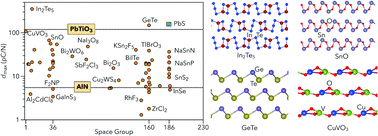Large piezoelectric response of van der Waals layered solids†
Abstract
The bulk piezoelectric response, as measured by the piezoelectric modulus tensor (d), is determined by a combination of charge redistribution due to strain and the amount of strain produced by the application of stress (stiffness). Motivated by the notion that less stiff materials could exhibit large piezoelectric responses, herein, we investigate the piezoelectric modulus of van der Waals (vdW) layered materials using first-principles calculations. From a pool of 869 known binary and ternary quasi-2D layered materials, we have identified 135 non-centrosymmetric crystals of which 51 are found to have piezoelectric modulus tensor (d) components larger than the longitudinal piezoelectric modulus of AlN, a commonly used piezoelectric material for resonators. We have also identified three materials with d components larger than that of PbTiO3, which is among the materials with the largest known piezoelectric modulus. None of the identified materials have previously been considered for piezoelectric applications. Furthermore, we find that large d components are always coupled to the shear or axial deformations of the vdW gap between the layers and are indeed enabled by the weak inter-layer interactions.



 Please wait while we load your content...
Please wait while we load your content...